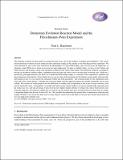Notice
This is not the latest version of this item. The latest version can be found at:https://dspace.mit.edu/handle/1721.1/122619.2
Deuterium Evolution Reaction Model and the Fleischmann-Pons Experiment
| dc.contributor.author | Hagelstein, Peter L | |
| dc.date.accessioned | 2019-10-17T21:01:54Z | |
| dc.date.available | 2019-10-17T21:01:54Z | |
| dc.date.issued | 2015 | |
| dc.identifier.issn | 2227-3123 | |
| dc.identifier.uri | https://hdl.handle.net/1721.1/122619 | |
| dc.description.abstract | The hydrogen evolution reaction model was proposed many years ago by the founders of modern electrochemistry. The closely related deuterium evolution reaction model describes deuterium loading in Pd cathodes in the Fleischmann–Pons experiment. We were interested in what issues were involved in the development of a high D/Pd loading, since over the years the importance of obtaining a high D/Pd ratio to obtain excess heat has been emphasized. In order to simplify things, we focus on the Volmer and Tafel reactions, and develop a steady state adsorption isotherm for the Vomer-Tafel regime. The adsorption isotherm is extended to become an absorption isotherm within a simplified picture that takes the surface sites to be equivalent to the bulk sites. While not a particularly good approximation, this allows us to model the D/Pd loading simply as a function of the overpotential, and hence the electrochemical current density. From a Tafel curve we can get some of the parameters for the Volmer current model, and from other eletrochemical data we can estimate the remaining Volmer and Tafel parameters. The resulting model fits the experimental data used well at low current density. Cathodes that load more highly with this approach require new models, potentially one for each cathode. We examine our earlier proposal that the differences in loading seen in experiment is due in part to large variations in the rate for internal D2 leaks. Consequently, we modify the Tafel reaction current model to account for internal leaks separately from the surface gas loss, and take advantage of data from the most highly loaded cathodes to estimate the surface Tafel reaction rate. Using this approach, the reference cathode that we used for our fits initially must have an internal leak rate more than two orders of magnitude higher than the rate of surface D2 loss. We conclude that minimizing the internal leaks is important in achieving high loading. Probably a key reason that there were so many negative results early in the field was because the cathode internal leak rate was very high in the cathodes used. Keywords: Deuterium evolution reaction; D/Pd loading; Overpotential; Tafel reaction; Volmer reaction | en_US |
| dc.language.iso | en | |
| dc.relation.isversionof | www.iscmns.org/CMNS/JCMNS-Vol16.pdf | en_US |
| dc.rights | Article is made available in accordance with the publisher's policy and may be subject to US copyright law. Please refer to the publisher's site for terms of use. | en_US |
| dc.source | Prof. Hagelstein | en_US |
| dc.title | Deuterium Evolution Reaction Model and the Fleischmann-Pons Experiment | en_US |
| dc.type | Article | en_US |
| dc.identifier.citation | Hagelstein, Peter L. "Deuterium Evolution Reaction Model and the Fleischmann–Pons Experiment." Journal of Condensed Matter Nuclear Science 16 (2015): 46-63 © 2015 ISCMNS | en_US |
| dc.relation.journal | Journal of Condensed Matter Nuclear Science | en_US |
| dc.eprint.version | Final published version | en_US |
| dc.type.uri | http://purl.org/eprint/type/JournalArticle | en_US |
| eprint.status | http://purl.org/eprint/status/PeerReviewed | en_US |
| dc.date.updated | 2019-10-10T14:42:48Z | |
| dspace.date.submission | 2019-10-10T14:42:49Z | |
| mit.journal.volume | 16 | en_US |
| mit.metadata.status | Authority Work and Publication Information Needed |
